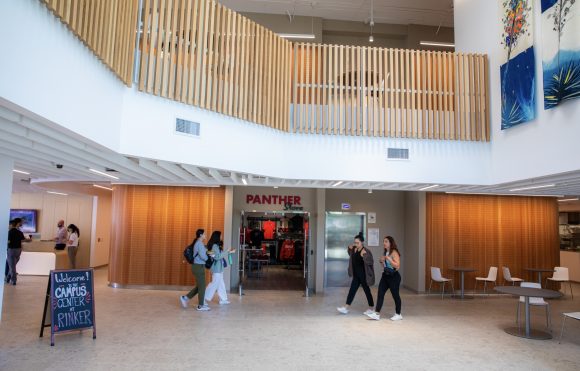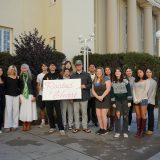The Escalette Collection Breathes New Life into the Rinker Campus
July 13, 2023
Wilkinson College’s Escalette Collection has expanded its ‘museum without walls,’ serving students in the much needed campus center at Chapman’s Rinker Campus for Health Science in Irvine. With a collection concentrated on the theme of ‘wellness,” dynamic pieces vitalize white walls and breathe life into newly constructed space, creating an environment conducive to improved mental well-being.

New Campus Center with textiles by iris yirei hu and Paula J. Wilson.
From the perspective of Campus Planning Project Coordinator Jillian Morris, partnering with the Escalette has brought better energy to campus. “Compared with the atmosphere of Rinker’s older facilities, the Campus Center is like a ray of sunshine, and I think a portion of that has to do with the art,” Morris stated.
This thoughtful selection of student serving art was a joint effort between multiple departments at Chapman. According to Jessica Bocinski, Collection Manager for the Escalette Collection, the Campus Planning and Design Department challenged the Escalette to curate a collection centered around wellness, nature, the southern California landscape, and the intersection between these elements.
The potential pieces were not only reviewed by Campus Planning and the Residence Life Manager at Rinker, but current Rinker Students as well. Despite not being in artistic majors, these students were integral in the selection process, choosing pieces that would resonate with their fellow students and uplift them during tough labs or finals.

Open loft area in Campus Center at Rinker with painting by Lisa Sanditz.
This interdisciplinary approach of creating educational spaces is present throughout the entire Rinker student center. The Escalette Collection hopes the art at Rinker will help facilitate a necessary bridge between STEM and the arts, despite these elements often being portrayed as opposing forces.
“I think that having fine art installations at a STEM campus represents the vital intersection between arts and sciences that our university is ardently pursuing. We can see many instances in our advancing society where technology and science have inevitably intersected with art, therefore our education system is taking more of a cross-disciplinary approach.” —Jillian Morris
Through this cross-disciplinary focus, The Escalette wants to encourage conversations that may not have occurred in a STEM centered space otherwise, such as through “Eufaula Girls.” This striking photograph was taken by Cara Romero, an indigenous photographer dedicated to both preserving her community’s traditions and affirming the existence of modern natives.
“As an Indigenous photographer, I embrace photography as my tool to resist Eurocentric narratives and as a means for opening audiences’ perspectives to the fascinating diversity of living Indigenous peoples.” —Cara Romero
In “Eufaula Girls,” Romero suspends Muscogee mother and daughter Lisa and Crickett Tiger in time as they fall through water. Referencing the 2015 flooding in Eufaula, Oklahoma, the Tiger women represent a precarious, yet crucial relationship between indigenous peoples and water. This thought provoking photograph is now housed at a Rinker study space, inviting students to engage in their own analysis of Romero’s simultaneously peaceful yet ominous indigenous narrative.

Cara Romero, Eufaula Girls, photograph printed on Legacy Platine paper, 2015. Purchased with acquisition funds.
Photos of Rinker Campus by Adam Hemmingway, Visual Content Director at Chapman University.
We invite you to explore all the works in the Escalette Collection by visiting our eMuseum.
Wilkinson College of Arts, Humanities, and Social Sciences is the proud home of the Phyllis and Ross Escalette Permanent Collection of Art. The Escalette Collection exists to inspire critical thinking, foster interdisciplinary discovery, and strengthen bonds with the community. Beyond its role in curating art in public spaces, the Escalette is a learning laboratory that offers diverse opportunities for student and engagement and research, and involvement with the wider community. The collection is free and open to the public to view.



